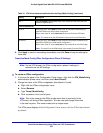
Virtual Private Networking Using IPSec and L2TP Connections
255
ProSafe Gigabit Quad WAN SSL VPN Firewall SRX5308
8. Click Apply to use the new settings immediately, and click Save to keep the settings for
future use.
Create the Mode Config IPSec Configuration (Phase 2 Settings)
Note: On the VPN firewall, the IPSec configuration (phase 2 settings) is
referred to as the IKE settings.
To create an IPSec configuration:
1. I
n the tree list pane of the Configuration Panel screen, right-click the GW_ModeConfig
authentication phase name, and then select New Phase 2.
2. Chan
ge the name of the IPSec configuration (the default is Tunnel):
a. Ri
ght-click the IPSec configuration name.
b. Select Rename.
c. T
ype Tunnel_ModeConfig.
d. Click anywh
ere in the tree list pane.
Note: This is the name for the IPSec configuration tha
t is used only for the
VPN client, not during IPSec negotiation. You can view and change this name
in the tree list pane. This name needs to be a unique name.
The IPSec pane displays in the Configuration Panel screen, with the
IPSec tab selected
by default:
NAT-T Select Automatic from the drop-down list to enable the VPN client and VPN
firewall to negotiate NAT-T.
Local and Remote ID
Local ID As the type of ID, select DNS fro
m the Local ID drop-down list because you
specified FQDN in the VPN firewall configuration.
As the value of the ID, enter clie
nt.com as the local ID for the VPN client.
Note: The remote ID on the VPN firewall is the local ID on the VPN client.
Remote ID As the type of ID, select DNS f
rom the Remote ID drop-down list because you
specified an FQDN in the VPN firewall configuration.
As the value of the ID, enter router
.com as the remote ID for the VPN firewall.
Note: The local ID on the VPN firewall is the remote ID on the VPN client.
Table 61. VPN client advanced authentication settings (Mode Config) (continued)
Setting Description


















